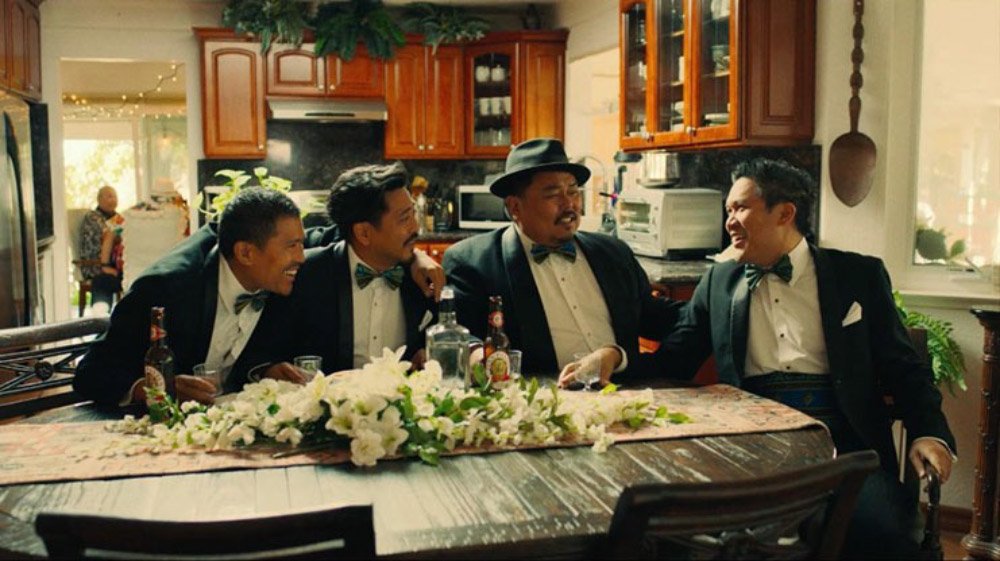This Filipino American Life
/Originally published in the International Examiner, March 7, 2022.
Darion, Dionysio, Derek and Dante Basco
Through the Abastas, this film tells the story of Filipino American families formed in the post-1965 immigration period. This is a work of love and joy by four multitalented real-life Basco Brothers—Derek, Dante, Dionysio, and Darion and their family and friends.
The opening colorful collages of the Basco brothers, from babies to adults in various activities, provide a warm lead-in to the four vignettes about each brother. The oldest, Dayo, is deemed by their little sister, Doris, as the reliable one. Duke is the lucky golden boy; David, the fun-loving, care-free one; Danny Boy, the one with the dark side. There are many ways to describe and understand this story. I’ve chosen three—the bell curve of the American dream, the infinite circle of “Jungle Asians,” and the kaleidoscope of multicultural, mixed-race Americans.
Bell Curve of the American Dream
Post-World War II America shows a bell curve or normal class distribution of where most folks aspired or expected to be, or were already in. A home in the emerging suburbs was the symbol of the American Dream. I love how the focus is on the East Bay suburbs and the “other Pittsburgh.” The Abasta brothers are American-born sons of successful post-1965 immigrants. The family home is spacious, filled with many rooms and huge dining tables as well as a tropical patio and garden. Food and drinks are plentiful and wide-ranging. There are trappings of an affluent, consumer-oriented middle class family. The brothers can be responsible or care-free, ambitious or lazy, self-centered or empathetic, dark or illuminating. They can compete or cooperate. Life is superficially good. When crises occur, we hear from their parents. Dad and Mom finally come to the story and assert themselves, telling their sons to grow up.
Infinite Circle of “Jungle Asians”
The Abasta brothers are also tribal. They call themselves “the Jungle Asians,” a tribe that is an infinite circle of multiple generations. The family home houses Lola/Grandma, Dad and Mom Abasta, oldest son Dayo, his Chinese American wife, Emily, and their numerous children. For the last two years, troubled brother Danny has resided in the children’s playroom. The social group protects the individual members.
“In the Abasta home, like many Filipino and Filipino American homes, you can always go in and out. You can always come home. There is always food to share and a place to sleep.”
In the Abasta home, like many Filipino and Filipino American homes, you can always go in and out. You can always come home. There is always food to share and a place to sleep. There is someone to talk to or someone who listens. Rituals of obligation and tolerance within the tribe are as important as social pastimes—from karaoke, to Cha Cha and gambling.
The brothers do not want to lose touch with Tagalog even as they mispronounce the Filipino foods they eat routinely. There are also the centuries-long rituals from colonization that bolster tribal binds. Catholicism is about saints and sinners. We accept or tolerate the good and bad; the wife and the mistress. We do it and confess. While Lola comes full circle to the acceptance of death, the younger generation reciprocates with the acceptance of life. Anna, Duke’s former girlfriend, chooses to bear her son out of wedlock. As Teresa, Danny’s new love tells him, “Love may not be forever but exists to create things, like other life.” Within the circle, men choose to father children who are not their biological offspring.
The Fabulous Filipino Brothers Movie Poster. Above: Darion, Dionysio, Derek, and Dante Basco. Bottom: Liza Lapira, Cheryl Tsai, and Solenn Heussaff
Multicultural, Mixed-Race Americans
In Pittsburg, California, as well as in other post-1965 immigrant communities, the circle has been replaced by a kaleidoscope, a constantly changing pattern or sequence of colorful objects or elements. Pan de sal and ensaymada (Filipino breads) get confused with Ensanada, Baja California. Familiar rituals make room for new. Some children live in their own households as married couples or single parents, but they still regularly return to the family home, even daily.
The role of women in the background, cooking for and serving the men and children continues, but take-out is readily available, and the men are also in the kitchen. They, too, help with Lola’s dialysis appointments. The strong silent type of Dad Abasta’s generation—where the women did most of the talking—makes way to younger sons who show a range of unabashed emotions. As little sister and nurse Doris says, “The story of my life. They don’t know they have a sister. It’s the women in the family who hold it down.”
For the fabulous brothers and sisters, the Philippines is no longer home but a place to visit as part of Asia. The Filipino American Community Center, a touchstone of pride for immigrant parents, becomes just childhood memories for their U.S.-born sons and daughters. In turn they bring forth multicultural and multiracial children and grandchildren, the common destiny of multigenerational Americans. They still believe in weddings in beautiful homes, or other splashy venues. They lead with their hearts, whether or not they know of America Is in the Heart by pioneer Filipino American writer Carlos Bulosan.
My one regret about The Fabulous Filipino Brothers is that the adult focus won’t make it a film for child-viewing.
****
The Fabulous Filipino Brothers can be streamed via Netflix, VUDU, Prime Video or Aoole TV.
Here’s the link to the original version: https://iexaminer.org/real-life-basco-brothers-present-a-significant-segment-of-the-kaleidoscope-that-is-the-filipino-american-community/




